The Three Water Project is a program that was initiated and managed by the Water Action Team on the South Store site of the First Alternative Natural Foods Co-op in Corvallis, Oregon. The project was primarily funded by the First Alternative Co-op, the City of Corvallis Public Works Department and the Corvallis Sustainability Coalition. Additional funding sources included the Corvallis League of Women Voters and the OSU Folk Club Thrift Shop. The project was initiated in 2010 and concluded in 2015.
Three Waters

The name “Three Waters” refers to the three municipal systems that both pipe and treat water.
Tap Water
The City draws and treats water at two sites. One-third of our water is from a reservoir held by a dam on Rock Creek at Marys Peak. Two-thirds of our water is drawn directly from the Willamette River in South Corvallis. All water we draw from each source removes water from the natural hydrological systems. In addition, treatment of the waters requires large amounts of fossil fuels for energy, harsh chemicals for cleaning the water, and costly infrastructure that requires constant and expensive daily maintenance. Water efficiency results in lower costs to the city, users and taxpayers, plus lower uses of fossil fuels for energy, harsh, toxic and dangerous chemicals and infrastructure. The First Alternative Natural Foods Co-op consumes high volumes of tapwater. In 2010, it was evident that at least 50% of this water use was not necessary for a highly functioning and profitable Co-op.
Waste Water
The City receives wastewater through its piping system at one site in Northeast Corvallis just off Route 20 south of the HP Campus. Most tapwater used indoors is drained as wastewater. Tapwater used for outdoor irrigation rarely drains as wastewater. Wastewater has all of the same cost and environmental issues associated with treatment, but an additional major issue is that the treated water is drained back into the Willamette River. The City uses a secondary treatment system and not the advanced tertiary treatment system found in some city wastewater systems. The water is not always in the best condition to support a healthy river. Reducing tapwater usage indoor reduces wastewater discharge. It is almost a one-to-one ratio.
In one-third of Corvallis, stormwater runoff from buildings and all paved surfaces is drained directly to the Wastewater Treatment Plant. For property owners of that one-third of the City, controlling stormwater runoff is critical for reducing wastewater treatment financial and environmental costs. During rainstorms, stormwater can be a larger contributor to wastewater treatment than drained tapwater. Stormwater is often more polluted than drained tapwater.
The First Alternative Natural Foods Co-op produces high quantities of wastewater from tapwater. In 2010, it was evident that at least 50% of this wastewater drainage was not necessary for a highly functioning and profitable Co-op. Much of this drainage reduction could result directly from tapwater efficiency.
Stormwater
Stormwater is rainwater that runs off pavement, roofs, and soil into municipal stormwater pipes. The stormwater running off the South Co-op property goes directly through pipes to the Mill Race, where it crosses under 99W. This drainage site is the most flood-prone site in the City of Corvallis. Reducing the amount of stormwater running off the South Co-op property would help reduce flooding along this busy transportation corridor. We determined we could reduce that amount of stormwater runoff from the South Co-op property by 50% annually.
Project Goals
To reduce use of tapwater and discharge of both wastewater and stormwater at the First Alternative Natural Foods Co-op South Store by 50% by July 2013 and have the Co-op serve as a model demonstration site for water conservation and efficiency in the City and region.
Background
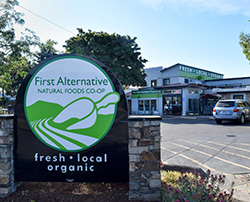
First Alternative Natural Foods Co-op, a Corvallis leader in sustainability practices, teamed with the Coalition Water Action Team to develop a demonstration project showing the process of development and financial results of more efficient on-site use and discharge of water.
The Co-op was chosen for this demonstration project for five reasons:
- The management and staff demonstrated enthusiastic interest to meet the project goals.
- The site provides a challenge, as a former industrial site fully developed by previous owners without consideration for water conservation and efficiency. It can serve as a model for all Corvallis properties.
- The Co-op is open 362 days of the year. The site is accessible by the public for viewing as a demonstration site.
- The Co-op generously provided much of the funding for the project.
- Stormwater from the South Co-op drains south along 99W to the Mill Race. This outfall site is the most flooded site in Corvallis.
Project Techniques
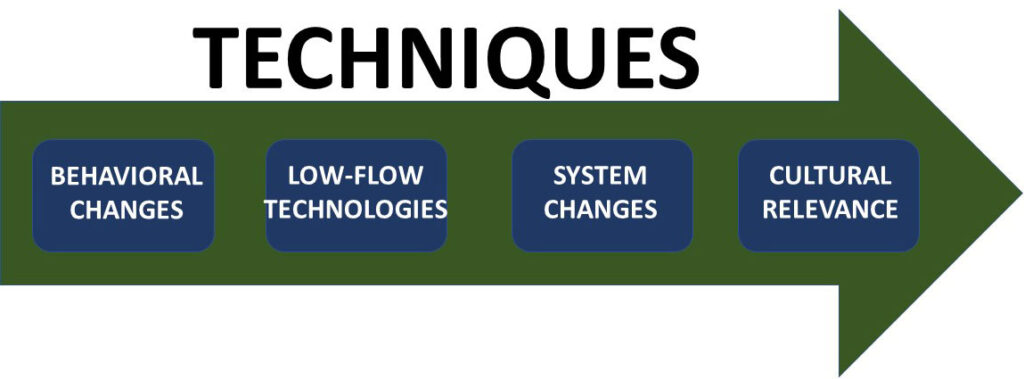
Four techniques reduce water use and discharge into municipal systems.
Behavioral Change
We surveyed the South Co-op’s department managers about water use and how they believe they can diminish use. We worked with staff to change water use behaviors. This technique requires training and monitoring. Financially, this is the easiest technique to incorporate. Following are examples.
- Flow Rate – Turn down water flow for each faucet, hose or sprayer use. We rarely need the high flow rates we use. Reducing flow rates can cut water use by 20-30%.
- Flow Time – Turn off water when not using it for short periods. It takes very little effort. Be more efficient and shorten the time to wash something. Cutting flow time on every water use can cut consumption and discharge by up to 30%, especially in commercial kitchens. This also cuts energy costs.
- Non-Essential Water Use – We often use large amounts of water out of habit that are unnecessary, such as cleaning pavement or vehicles. By surveying water use at the South Co-op, we discovered instances where substitute techniques could be implemented to reduce or eliminate water use to meet the Co-op’s goals. Achieving these goals requires behavioral changes.
- Paving & Building Expansion/Reduction – Avoid further paving of property or expanding the footprint of buildings over the land. The more a property is paved or built upon, the more stormwater runs off the property during a rain and into the municipal system, unless there are other space-consuming mitigation facilities constructed. Runoff costs all taxpayers money and leads to further degradation of our streams and rivers. Behavior change is required to stop the habitual drive to pave and build. Prior owners of the site had areas paved where there is no current need for pavement. Buildings and sheds were added in the past when space could have been used more efficiently. It is more economical to look for an alternative to paving and building.
Low-Flow Technologies
Tapwater and Wastewater – Following a survey of over 50 South Co-op tapwater sources, we installed water flow meters to determine which sources consumed excess water. We determined which water sources would benefit from low-flow appliances or reducers and which sources needed automatic controls to over-ride excess manual use. Following are examples:

- Low-Flow Inhibitors – Tapwater faucets, hoses, and sprayers can all be modified for reduced water flow and at higher pressure. Following a survey of flow adapters at the South Co-op, we purchased sprayers that have a lower volume of flow, but a higher pressure. The result is the same level of force emitted to clean whatever is needed, but with much less water. Less tapwater use computes to less wastewater discharge.
- Water Appliances – Electric and gas appliances that use water, such as washing machines and dishwashers, often use far more water than is necessary for the job. Replacing old appliances and toilets with new ones that have Energy Star ratings can cut water use per cycle by 50% or more. New low-flow toilets can also save 20-60% water use over older models. The first appliance to be changed at the South Co-op was a washing machine that washes four loads, 362 days of the year. This resulted in significant water savings, reduced electrical use and far less soap and water used and discharged into the wastewater system. Toilets and dishwashers were also replaced.
- Automatic Water Systems – At the South Co-op, some water sources are on automatic systems. Two automatic sources that use a high volume of water are the outdoor landscape irrigation system and the indoor produce display case spray system. The automatic systems are not set to the true needs of the water users, but to manufacturer settings. By gradually lengthening the time intervals between spraying and reducing the spray time for each application, the amount of water can be reduced by 50% without reducing productivity.
System Changes
A system change involves changing the entire methodology of how water is consumed or drained by creating an alternative process that requires little or no water or re-uses water instead of draining it to a City system. System changes start with a survey to prioritize water usage or drainage and to determine where system change is feasible. The challenge to system change is primarily changing an accepted practice. Water uses were identified at the South Co-op for system change.
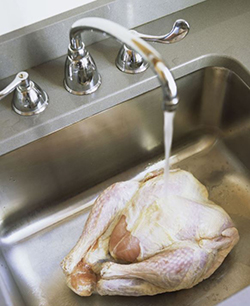
- Tapwaterand Wastewater
- Defrosting frozen meat by running water over the meat is the most common thawing practice among restaurants in Oregon. It is recommended by the State Health Department. The downside is using huge quantities of water, all of which flows to the wastewater treatment plant for chemical and physical treatment. A water-free alternative is to slowly defrost meat in a refrigerator. Such a system change requires additional forethought by the kitchen staff, but it could save a business the costs of thousands of gallons of water per day.
- Tapwater – Landscaping with emphasis on native, drought-tolerant plants and mulch eliminates the need for most irrigation.
- Stormwater – We administered a site survey to analyze how stormwater flowed off the property and into the municipal storm drainage pipes. From that data, we developed a plan to reduce and slow down or eliminate the stormwater runoff. Following are examples.

- De-Pave Impermeable Surfaces – Most of the South Co-op property is covered with pavement and buildings. The site was surveyed, and it was determined where paved areas were no longer required. Three sites were de-paved.
- Rain Gardens – The three de-paved sites were replaced by raingardens that include nutrient-rich soil with a high infiltration rate and diverse wetland native plant species.
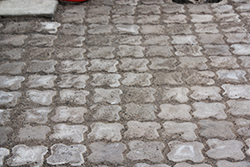

- Permeable Pavers – A variety of commercial and non-commercial permeable pavers were installed at one de-paved site. Examples included:
- Expensive, aesthetically pleasing pavers
- Middle-priced common pavers
- Low-cost planter pavers – Standard concrete pavers include spaces into which we planted “steppable” plants. The end result is a vegetated walkway that supports significant weight and structure even during wet months.
- Low-cost brick pavers
- No-cost recycled bottles and tumbled glass pavers

- Rainwater Collection – Thousands of gallons of water drain off each rooftop for every inch of rain. Most of the rooftop runoff in Corvallis flows directly into the municipal stormwater piping system. In one-third of the City, the stormwater is mixed with raw sewage and piped to the wastewater treatment plant. Every time it rains, this runoff costs taxpayers significant tax dollars. In two-thirds of the City, the rooftop runoff that goes into the municipal system runs directly and within minutes into our urban streams, scouring the stream channels, flushing out life and depositing harsh pollutants into the aquatic ecosystem. One of the most basic steps a building owner can take to remedy this problem is to install rain tanks that capture the rooftop runoff and later use it for irrigation. With sufficient storage capacity, 50-80% of rainwater drainage from buildings can be captured and re-used. The captured rainwater can then reduce the significant irrigation costs during dry periods.
- Living Wall – A living wall is a vertical structure designed to support plant species. It provides stormwater runoff mitigation benefits, as well as a thermal buffer and energy reduction for buildings. One living wall was installed by a rain tank on the southeast corner of the South Co-op.

- Wastewater
- Greywater Re-Use – Every business and most homes drain to the wastewater system thousands of gallons of used, but not polluted, water each month that could be re-used for irrigation or toilet flushing. There are strict laws on how greywater can be used. We installed one such system, but after two years of use, it failed and could not be repaired.
Cultural Relevance

Aesthetics
For all installations, we considered aesthetic impacts on the business site. Such aesthetic qualities were built into the design. Such techniques involved painting, plant selection and shielding elements of the working features.
Convenience
We had two foundational considerations for every step in our process.
- Enable the South Co-op’s business model to function without interruption.
- Ensure customer convenience is enhanced or at least not limited in any way by our work.
Interpretation

We designed methods for staff, customers and the public to understand what we were doing and why we were doing it. Techniques included:
- Interpretive displays explaining system components
- Graphic exhibits showing water usage and savings
- Murals that relate to water and water efficiency
- In-person meetings with staff and interested organizations
- Onsite and offsite public and private tours
- Onsite and offsite public and private presentations
- Onsite and offsite public and private classes about system component design and installation
- Media articles and press releases
- Reports to relevant agencies
Sense of Place
Our intent was that water efficiency components become ingrained into the culture of the South Co-op. The presence of the system components provide a special sense of place that is expected by staff and customers to see and experience. This sense of place provided by the water efficiency components improves the already positive feelings the community has for the site.
Program Accomplishments

Program goals met
Analysis performed at the end of the project indicated that:
- Tapwater usage was annually reduced by 50% when compared to usage at project initiation,
- Wastewater drainage was annually reduced by 50% when compared to project initiation, and
- Stormwater drainage was annually reduced by 50% when compared to project initiation.
- Demonstration site – Program outreach in the form of media coverage, public and private tours, on-site interpretive displays, presentations to local agencies and organizations, public involvement with program projects, and collaboration with OSU on project designs and installation all combined to develop the site as the intended demonstration of the three waters conservation that was intended.
Project elements completed

- De-paving & soil/ecological regeneration – Three sites were de-paved. One site had three parallel layers of pavement requiring removal with 6-12” of soil between them. One site had two parallel layers of pavement requiring removal. One site had only one layer of pavement. The succeeding underlayers of pavement represented previous on-site development with efforts to elevate the topography out of the flood plain of the Marys and Willamette Rivers. Soil and compost were imported from SoilSmith Services of Corvallis in all three sites. Compost tea was injected into one of the regenerated sites that became a raingarden.

- Raingarden installations – Raingardens were designed and installed for all three de-paving sites. Two of the sites were 100% converted into raingardens that received stormwater runoff from adjoining rooftops. The third area converted only 20% of the area into a raingarden. The remaining 80% of that site was converted to permeable pavers so that it could continue to be a highly-used site.
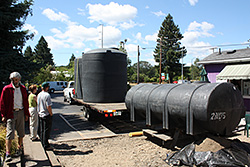
- Rainwater harvesting systems
- Received first-ever City permit to legally install rainwater harvesting
- Installed 17 rain tanks with a total of over 18,000 gallons of rainwater collection capacity, collecting from the rooftops of the South Co-op store, meeting room and drive-thru coffee shop
- Developed irrigation uses for the harvested rainwater and delivery systems that included both human and solar power
- All rainwater harvesting systems were purchased locally from JTI Supply in Linn County
- First Stormwater Biochar Filters in Corvallis – We worked with the Pacific Northwest Biochar Initiative, and they designed, created and installed special stormwater filters filled with biochar to clean stormwater that was flowing off the adjacent parking lots into our raingardens. This was the first recorded site using biochar filters in Corvallis.
- Irrigation efficiency and elimination – We analyzed water use for irrigation and discovered significant water overuse from the automatic system, plus further wastage from broken irrigation pipes and faucets that were malfunctioning. We proposed irrigation maintenance, a new irrigation setting for the automatic system, and replacing non-native plants with drought-tolerant native plants. The Co-op agreed, resulting in the single greatest water saving for the entire project.

- Greywater treatment and re-use system installation
- Received first-ever City permit to legally install greywater treatment and re-use
- Installed a state-of-the-art on-site treatment system to collect and treat water draining from public bathroom sinks and then send the reclaimed, treated water to be used for toilet flushing
- Sponsored the graywater project that was designed by an OSU Senior Capstone Engineering team
- Water efficiency policy
- The First Alternative Natural Foods Co-op approved the first business water- efficiency policy in the City of Corvallis.
- The policy was developed in coordination with an OSU Master’s Project in Water Policy.
- We presented the policy as a model for Benton County to Benton County staff.
- The policy is available to other businesses as a model.

- Water appliance efficiency installations:
- o.8-gallons/flush Niagara Stealth toilets throughout the facilities
- 13-gallon water use/load Bosch washing machine
- On-demand water heater

- Spigot/faucet water use efficiency – We placed water meters on high use faucets and used those findings to recommend water use efficiencies. The greatest efficiencies were found in the South Co-op kitchen.
- Meat Defrosting – The number one overuse of indoor water was the constant water flow over frozen meat to defrost it in the Co-op kitchen. This is the legally recommended and most used technique for meat defrosting in Corvallis. We convinced the Co-op to use their plentiful refrigeration space to plan meat use in advance and defrost it by moving it from the freezer to the refrigeration one day in advance of use. This practice virtually eliminated the most egregious indoor overuse of water at the South Co-op.
Water Conservation Collaborations
- Existing Co-op staff – For four years, we worked with Co-op management to train staff in water efficiency practices. There was great enthusiasm and participation by staff in reducing unnecessary water use.

- OSU, Lane Community College, Crescent Valley High School, and Corvallis Waldorf School
- Students from the OSU Engineering Department used the Three Waters Project from 2012-2015 for Senior Capstone Projects. Following completion of the Three Waters Project, the Engineering Department asked the Water Action Team to continue mentoring Capstone Project students for water efficiency on OSU Campus. We continued in that role until 2020, when the COVID pandemic erupted.
- Students and faculty of the OSU Horticultural Department designed and installed a raingarden and a living wall.
- A Master’s student from Water Resource Policy and Management developed a South Co-op Water Efficiency Policy that was adopted by the Co-op. The policy included:
- Corporate Water Efficiency Policy – A 3-page policy statement covers tapwater use, plus wastewater and stormwater discharge mitigation techniques.
- Water Efficiency Installation Plan – A 5-page plan outlines remaining water mitigation features to be installed for the project.
- Water Efficiency Maintenance Plan – A 14-page plan outlines all maintenance considerations for the water efficiency features.
- Water Efficiency Marketing Plan – A 6-page marketing plan outlines details for marketing water efficiency at the South Co-op.
- Water Efficiency Policy Research – Examples of water efficiency policies by national corporations were collected and studied for local use.
- Lane Community College provided two students from their Water Conservation Technologies program to provide us with design and installation work.
- Crescent Valley High School Interns – Helped to install
- Non-commercial permeable pavers
- A raingarden
- Corvallis Waldorf School Students – Designed, painted, and installed two murals of Corvallis’ two municipal water sources – Marys Peak and the Willamette River
Outreach
- Free classes were offered both on-site and off-site for both private organizations and the general public on a regular basis over a 4-year period on the following subjects:
- Greywater Systems
- Lowering Your Water Bills
- Raingarden Design and Installation
- Rainwater Harvesting Design and Installation
- Water Conservation Techniques

- Interpretive Displays were installed indoors and outdoors on-site with the first installation in 2008. Seven of the displays are still in place on-site. The interpretive displays were crafted and printed by Element Graphics of Corvallis.
- Tours of the site and its water efficiency components were offered to private parties and to the general public over a 3-year period.
- Presentations with PowerPoint slide shows were provided to organizations, agencies, schools and conferences over a 4-year period.
- Exhibits were displayed for public and private events in Corvallis showing water efficiency component models over a 4-year period.

- Murals – Two large murals designs, painted and installed by the Waldorf School of Corvallis students and faculty. The murals represent the two water sources for the City tapwater system – Marys Peak and the Cascades/Willamette River. The beautiful mural has weathered well for over 10 years, and each mural shields a 3,000-gallon rainwater collection tank.
- Graphic Water Usage Wall Charts – Large water efficiency graphs were mounted and updated monthly in all public and staff bathrooms showing water usage. The purpose was to provide feedback to all staff and the public regarding the success of the water efficiency program. With the completion of the program, the indoor water efficiency graphs were removed.
Program Challenges
- Rainwater Harvesting – When designing each of the rainwater harvesting tank installations, a designated use for that water was part of the design. In each case, the purpose was irrigation of a specific landscaped area. Unfortunately, changing site needs, landscaping needs and delivery pipe functionality led over time to most of those uses no longer being relevant, or staff was unable to provide the maintenance needs of the irrigation delivery. A couple of tanks also had to be removed due to changes in facility needs. The overall system is still functional, but all of the imbedded values have not been realized years after the conclusion of the construction and oversight. A renewed effort could reinstate these functional values.
- Greywater Systems – About a year following the conclusion of the Three Waters Project, the commercial greywater treatment system malfunctioned. The greywater systems company, however, had gone out of business, and there was no one available who could fix or account for the system’s problems. As a result, the system has been shut down since 2016. There is no further funding to seek alternatives.
- Staff training – Staffing for food stores is historically transient and has become more transient in recent years. A water efficiency training program needs to be put into action.
- Changing business/site needs – A food store has constant changes in site needs. A serious site fire and other unforeseen changes resulted in less efficiency in many of the installed systems.
- Program ovesight – With the end of project oversight by the Water Action Team, it is difficult for the Co-op with all of its priorities to maintain the various installed systems.
- Non-commercial permeable pavers – Whereas the commercially purchased pavers have worked well over the past 10 years of service, the non-commercial pavers required removal and are not recommended.
- Human and Solar Powered pumps for irrigation – In an effort to provide irrigation efficiencies with rain tank water, we purchased and installed both solar-powered and human-powered pumps. The solar power panels were at ground level and were vandalized. The hand- and bike-powered pumps were rarely used and then quickly deteriorated with outdoor weather.
Resources
Click on the following videos and websites for further information.
- Water Sustainability video about Three Waters Project by Perry Bowling, OSU student.
- Reining in the Storm – One Building at a Time video about the reasons and components for Low Impact Development techniques to clean and control stormwater runoff to improve the health and functionality of our local streams and rivers. By Dave Eckert and the Low Impact Development Center
- Reviving an Urban Stream video about urban creeks and what we can do on our properties and through local government to revive our local streams. By Dave Eckert and the Northern Virginia Regional Planning Commission
- Riversmart Rainwater Collection video about how to install a small residential rainwater collection and distribution system. By Dave Eckert and the Washington, D.C. Department of the Environment
- How to Install a Greywater Irrigation System video by This Old House and Greywater Action
- Corvallis Tapwater Treatment and Delivery System
- Corvallis Wastewater drainage and treatment system
- Corvallis Surface Water (Storm Water) Management
- Stormwater Program | Corvallis Oregon
- Pacific Northwest Biochar Initiative
- JTI Supply – Rainwater Harvesting Systems
- First Alternative Natural Foods Co-op

